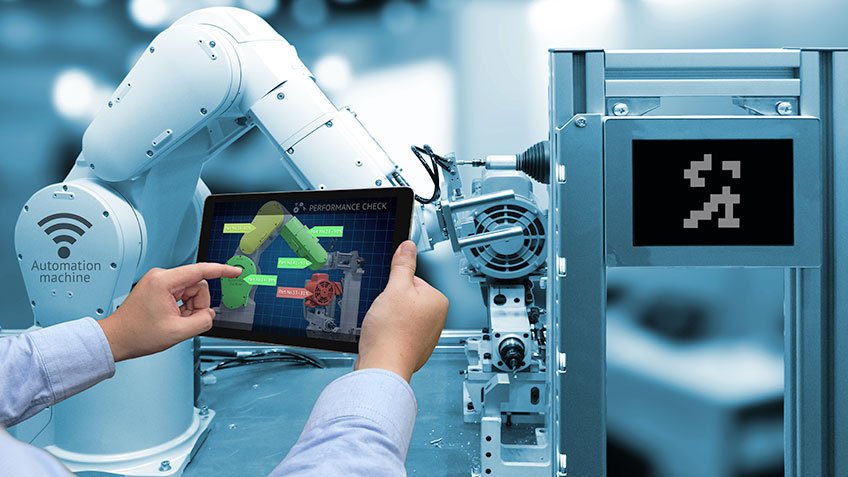With greater requirement for production and machine information, comes the need for industrial grade smart devices. Smart devices are integral components for smart machines and are the first step to capture operational data. These smart devices help enable you to make smarter, more informed decisions.
By 2020, industrial producers are on track to exceed 50 billion connected devices across their enterprise, along with multiple Industrial Internet of Things (IIoT) applications that depend on them. As the pace of digital transformation increases, manufacturers need to invest in new smart devices, machines and equipment to remain competitive.
How Can Smart Devices Improve Productivity?
Smart devices help to improve product quality, reduce downtime and future-proof your investment in smarter machines to allow for smarter manufacturing.
1. Monitor Machine Health
Smart devices provide visibility on the health of machines. Generating real time diagnostic data, problem areas and performance trends are identified and communicated via local and remote dashboards, giving you the information you need to make the right decisions and optimize your production process.
2. Increase Uptime
Predictive service greatly increases machine availability by minimising unnecessary maintenance. The combination of Ethernet/IP connected condition-based monitoring and electronic overload protection provides highly accurate and reliable motor data. The result is greatly improved asset utilization across manufacturing operations.
3. Improve Manufacturing Agility
Commissioning a new machine is more efficient using smart devices. Automatic device configuration downloads configure smart devices in milliseconds instead of minutes. Issues are resolved up to 90 percent faster with minimised disruption or downtime. Plug and play devices and multiple sensor profiles allow fast changeover of production for flexible smart manufacturing.
4. Increased Safety and Productivity
Safety and control are at the heart of a manufacturing system. When a production issue occurs, the operator is only allowed to access the machine or equipment to correct the problem when the system deems it safe to do so. All interactions are automatically logged so the historical data can be used in application adjustments for greater efficiency and reduced issues.
5. Lower Cost of Ownership
The single source solution provided by Rockwell Automation provides a consistent, intuitive programming environment; helps reduce complexity and simplifies troubleshooting. Once integrated, smart devices increase productivity and flexibility, minimise downtime and reduce total cost of ownership.
Sensors are Getting Smarter
Unless you are aware of what is happening on machines installed in factories minute-by-minute, it is impossible to maintain optimum productivity and efficiency at all times, or to avoid unplanned downtime and loss of production.
Conventional sensors can provide only a limited amount of information but lack the capability to offer diagnostic or parameter data to exchange with a controller. An integrated smart sensor solution provides all the data required to create a comprehensive picture of the status of an enterprise at any particular moment. As integral components of The Connected Enterprise®, smart sensors can also facilitate the introduction and operation of smart machines for even greater efficiency and productivity.
Smart sensors help you merge disparate data into streams of actionable information and allow assets to be monitored and optimized from anywhere in real-time. Rockwell Automation has recently expanded their portfolio of smart sensors – the foundation of integrated control and information – which provides the raw data for The Connected Enterprise®.
The new Allen-Bradley 42AF RightSight M30 photoelectric sensor is the latest addition to the smart sensing portfolio. Built with improved environmental resistance and long-distance detection in a mid-sized, right-angle housing, the RightSight M30 smart sensor offers the flexibility and performance required for a wide range of high-demand applications.
“Our new photoelectric sensor was developed to help increase reliability in harsh environments where dirt or undesired particles could accumulate on the sensor lens,” says Adonis Evangelista, product manager, Rockwell Automation.
The durable, right-angle housing offers a universal 30 mm nose and 18 mm base mount for fast, flexible installation and replacement. The IP67/IP69k/1200 psi rated housing is fully sealed, enabling the RightSight M30 to withstand tough industrial environments, including those involving high-pressure and high-temperature washdowns. Featuring multiple sensing modes, the sensor is also available in easy-to-apply, adjustment-free models and teachable versions that adjust sensitivity and output configuration at the push of a button
Built with IO-Link capability, the sensor easily integrates into The Connected Enterprise® by delivering data and diagnostics from the sensor directly into a control system to help minimize downtime and increase productivity. With this capability, the sensor provides information such as signal strength, location, proximity alarms and timing functions that help create operational efficiencies and streamline troubleshooting.
With smart sensors available for every possible parameter – from pressure to temperature, motion to distance, level to flow and many more – it is possible to sustain a comprehensive view of your process. Knowledge of current sensor situation and status also ensures timely identification of any type of potential sensor issue.
Integrated smart sensor solutions can help provide at least 5-10 percent production increase. When combined with a smart safety solution, this productivity increase can be further amplified.


